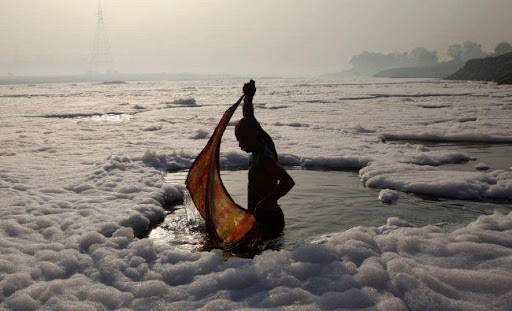
Post Diwali, the national capital and its adjoining regions experience a severe pollution crisis. The water bodies in Delhi, especially the Yamuna River near the Kalindi Kunj area, have become entirely toxic. A rower even claimed that the river was very toxic and hazardous. There are no fish in the river due to a lack of oxygen.
He said, “the water is very dirty from the past few days in the Yamuna. No one is doing anything to clean it up. Earlier we used to take a bath in the river and drink its water. Now, no one comes here.”
Yamuna river fulfills three-quarters of the capital’s water needs. Regardless, several industrial units pollute the water of the river daily. It should be noted that the cleaning of Yamuna is a part of the Namami Gange Mission. Consequently, the Government of India has been supplementing the states' efforts to check the river Yamuna's rising pollution levels at a River Ganga tributary. It has been providing financial assistance to the States of Haryana, Delhi, and Uttar Pradesh in a phased manner since 1993 under the Yamuna Action Plan (YAP).
The picture illustrates how pollution has destroyed the Yamuna River. Delhi government has banned the sale, storage, transportation, and marketing of soaps and detergents not conforming to the latest BIS parameters to curb pollution in the Yamuna River.
According to an official of the Central Pollution Control Board, the primary reason behind the formation of the toxic foam in Yamuna is the high phosphate content in the wastewater because of detergents used in dyeing industries, dhobi ghats, and households. These detergents and other organic matter get deposited in the riverbed when flowing naturally. This phenomenon leads to the formation of toxic foam all over the Yamuna River.
One of the advantages of the lockdown was lesser pollution in the Yamuna River. As industrial activity stopped and other commercial activities halted, the river cleaned itself. Thus, allowing numerous Indian and migratory birds to flock to its waters. However, as river pollution in the national capital remains poor, a thick layer of toxic foam has again enveloped the Yamuna River.
Despite the government’s expenditure of around 48 crores on sewer networks and treatment plants, industrial and sewage waste continues to flow into the Yamuna unchecked. The Karwan River joins the Yamuna named Jharna Nala, carrying industrial waste from Hathras. It remains full of chemicals that form a toxic foam where the two rivers meet. Today, people have turned away from the rivers. If they link their lives to the river again, seeing their plight, they will try to improve upon it. DR. K P Singh highlighted that a National River Commission should be set up, and a policy should be prepared for the conservation and flow of the rivers. It is necessary to clean our rivers as they are an essential part of civilization.